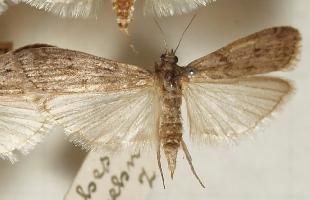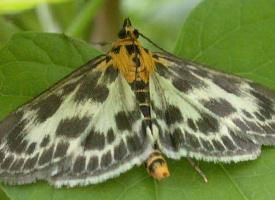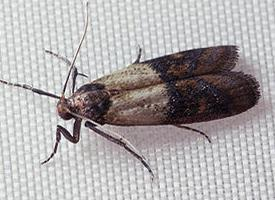
Poids et mesures
| Envergure des ailes | de 20 à 25 mm |
|---|
Description de l'animal
The Mediterranean flour moth, scientifically known as Ephestia kuehniella, is a species of moth belonging to the family Pyralidae. This moth is particularly well-known for its larval stage, which is considered a major pest in grain storage and processing facilities. The species has a cosmopolitan distribution, having spread to various parts of the world from its origins, presumably in the Mediterranean region.Adult Mediterranean flour moths exhibit a distinctive appearance. They possess a wingspan ranging from 20 to 30 millimeters. The forewings are grayish and adorned with wavy black and white lines, which create a marbled effect. These patterns serve as excellent camouflage against the backgrounds of storage facilities and grain bins where they are commonly found. The hindwings are lighter in color, usually a pale gray or white, and are less conspicuously marked than the forewings. The body of the moth is slender and elongated, with a pronounced "snout" formed by the palps projecting from the head, a characteristic feature of moths in the Pyralidae family.
The lifecycle of the Mediterranean flour moth begins when a female lays her eggs in a suitable food source, such as flour, grains, or other stored food products. The eggs are tiny, white, and are often laid in clusters. Upon hatching, the larvae, commonly referred to as caterpillars, emerge and immediately begin feeding on their surroundings. These larvae are creamy-white with a brown head capsule and can grow up to 20 millimeters in length. As they feed, they spin silken threads, creating a web-like structure that can clog machinery and spoil food products. This webbing, combined with their feeding habits, can lead to significant economic losses in affected industries.
After reaching maturity, the larvae pupate within a cocoon woven from silk. The pupal stage lasts approximately two weeks, after which the adult moths emerge, ready to mate and continue the cycle. The entire lifecycle from egg to adult can be completed in as little as five weeks under optimal conditions, allowing for multiple generations to occur within a single year.
The Mediterranean flour moth is particularly challenging to control due to its ability to thrive in the small cracks and crevices within food processing and storage facilities. Traditional control methods include meticulous sanitation practices to remove food sources and breeding grounds, the use of pheromone traps to monitor and reduce adult populations, and, where appropriate, the application of chemical insecticides or natural predators.
In summary, the Mediterranean flour moth is a significant pest in the agricultural and food processing industries, known for its distinctive appearance and the economic damage caused by its larvae. Effective management of this pest requires a comprehensive approach, combining sanitation, monitoring, and, when necessary, targeted control measures to minimize its impact on food storage and processing operations.
Animaux similaires
Nouvelles photos d'animaux
Top 10 des animaux
- Dolphin gull (Leucophaeus scoresbii)
- Japanese macaque (Macaca fuscata)
- Stone loach (Barbatula barbatula)
- Greek tortoise (Testudo graeca)
- Russian tortoise (Testudo horsfieldii)
- Galápagos tortoise (Geochelone nigra complex)
- Diana monkey (Cercopithecus diana)
- Moustached guenon (Cercopithecus cephus)
- Common flying dragon (Draco volans)
- Galápagos penguin (Spheniscus mendiculus)


